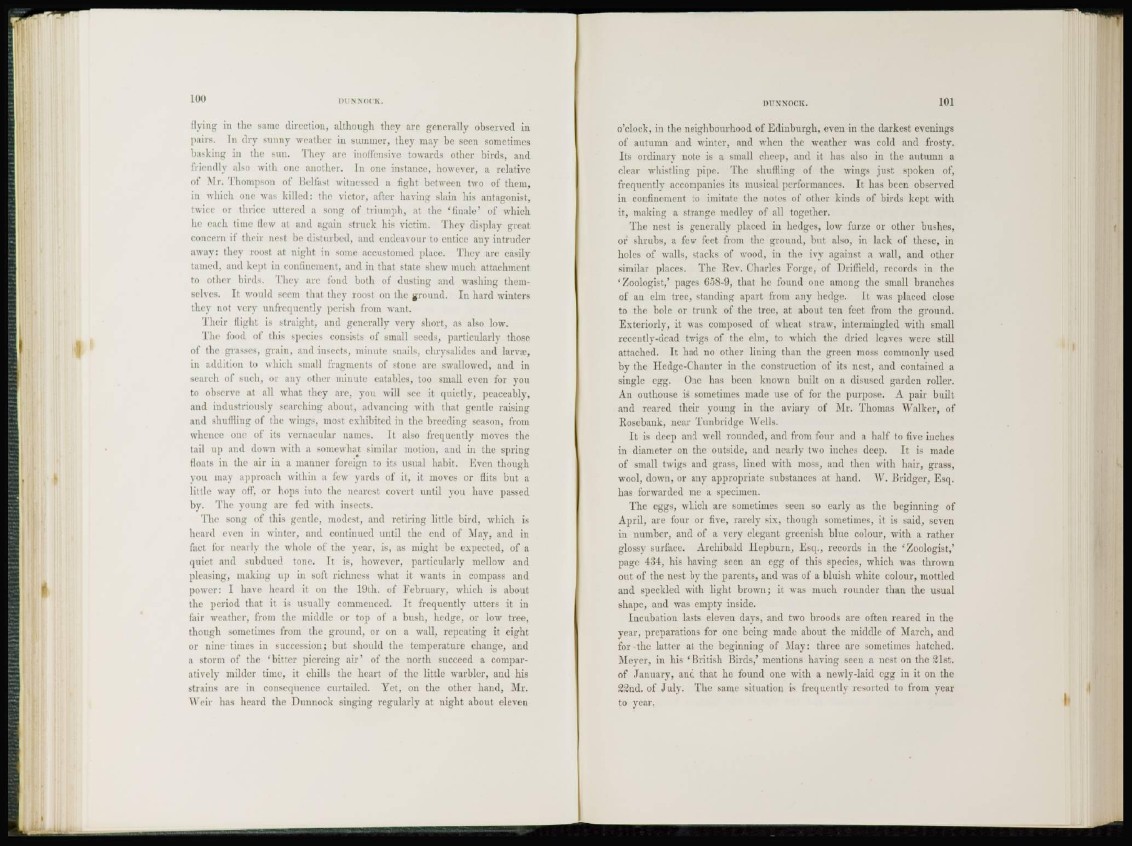
100 niNMIl'K.
Hying in the same direction, although they are generally observed in
pairs. In dry sunny weather in summer, they may be seen sometimes
basking in the sun. They are inoffensive towards other birds, ; i nd
friendl) also with one another. In one instance, however, a relative
"1' Mr. Thompson of Belfast witnessed a fight between two of them,
in which one was killed: the victor, after having slain his antagonist,
twice or thrice uttered a song of triumph, at the 'finale' of which
he each time flew at and again struck his victim. They display great
concern if their nest be disturbed, and endeavour to entice any intruder
away: they roost at night in some accustomed place. They are easily
tamed, and kept in confinement, and in that state shew much attachment
to other birds. The) are fend both of dusting and washing themselves.
It would seem that they roost on the ground. In hard winters
the} not very unfrequently perish from want.
Their flight is straight, and generally very short, as also low.
The food of this species consists of small seeds, particularly those
of the grasses, grain, and insects, minute snails, chrysalides and larva:,
in addition to which small fragments of stone are swallowed, and in
search of such, or any other minute eatables, too small even for you
to observe at all what they are, you will see it quietly, peaceably,
and industriously searching about, advancing with that gentle raising
and shuffling of the wings, most exhibited in the breeding season, from
whence 0m1 of its vernacular names. It also frequently moves the
tail up and down with a somewhat similar motion, and in the spring
floats in the air in a manner foreign to its usual habit. Even though
you may approach within a few yards of it, it moves or Hits but a
little way off, or hops into the nearest covert until you have passed
by. The young are fed with insects.
The song of this gentle, modest, and retiring little bird, which is
heard even in winter, and continued until the end of May, and in
fact for nearly the whole of the year, is, as might be expected, of a
quiet and subdued tone. It is, however, particularly mellow and
pleasing, making up in soft richness what it wants in compass and
power: I have heard it on the 19th. of February, which is about
the period that it is usually commenced. It frequently utters it in
fair weather, from the middle or top of a bush, hedge, or low tree,
though sometimes from the ground, or on a wall, repeating it eight
or nine times in succession; but should the temperature change, and
a storm of the 'bitter piercing air' of the north succeed a comparatively
milder time, it chills the heart of the little warbler, and his
strains are in consequence curtailed. Yet, on the other hand, Mr.
Weir has heard the Dunnock singing regularly at night about eleven
nrxxocK. 101
o'clock, in the neighbourhood of Edinburgh, even in the darkest evenings
of autumn and winter, and when the weather was cold and frosty.
Its ordinary note is a small cheep, ami it has also in the autumn a
clear whistling pipe. The shuffling of the wings just spoken of,
frequently accompanies its musical performances. It has been observed
in confinement to imitate the notes of other kinds of birds kept with
it, making a strange medley of all together.
The nest is generally placed in hedges, low furze or other bushes,
or shrubs, a few feet from the ground, but also, in lack of these, in
holes of walls, stacks of wood, in the ivy against a wall, and other
similar places. The Rev. Charles Forge, of Driffield, records in the
'Zoologist,' pages 658-9, that he found one among the small branches
of an elm tree, standing apart from any hedge. It was placed close
to the bole or trunk of the tree, at about ten feet from the ground.
Exteriorly, it was composed of wheat straw, intermingled with small
recently-dead twigs of the elm, to which the dried leaves were still
attached. It had no other lining than the green moss commonly used
by the Hedge-Chanter in the construction of its nest, and contained a
single egg. Oue has been known built on a disused garden roller.
An outhouse is sometimes made use of for the purpose. A pair built
and reared their young in the aviary of Mr. Thomas Walker, of
Roscbauk, near Tunbridgc "Wells.
I t is deep and well rounded, and from four and a half to five inches
in diameter on the outside, and nearly two inches deep. It is made
of small twigs and grass, lined with moss, and then with hair, grass,
wool, down, or any appropriate substances at hand. W. Bridgcr, Esq.
has forwarded me a specimen.
The eggs, which are sometimes seen so early as the beginning of
April, are four or five, rarely six, though sometimes, it, is said, seven
in number, and of a very elegant greenish blue colour, with a rather
glossy surface. Archibald Hepburn, Esq., records in the 'Zoologist,'
page 434, his having seen an egg of this species, which was thrown
out of the nest by the parents, and was of a bluish white colour, mottled
and speckled with light brown; it was much rounder than the usual
shape, and was empty inside.
Incubation lasts eleven days, and two broods are often reared in the
year, preparations for 011c being made about the middle of March, and
for the latter at the beginning of May: three arc sometimes hatched.
Meyer, in his ' B r i t i sh Birds,' mentions having seen a nest on the 21st.
of January) and that he found one with a newly-laid egg in it on the
22nd. of July. The same situation is frequently resorted to from year
to year.